Read Hank Reinhardt's Book of Knives: A Practical and Illustrated Guide to Knife Fighting Online
Authors: Hank Reinhardt
Hank Reinhardt's Book of Knives: A Practical and Illustrated Guide to Knife Fighting (15 page)

Now that you have your sparring knives, mark a line on the bottom sides to position the edges, so when you cut you won’t be cutting with the “flat” of the newspaper.
You will need some kind of eye protection. There are several commercial brands of sports glasses that can work with this. Also, a full-coverage helmet is not a bad idea. It is difficult to practice using a weapon without picking up some kind of injury. You can reduce the amount of suffering involved if both you and your partner spar carefully and obey whatever rules you pass to govern this activity. I used these paper knives for years with Hank and was never injured. This was not just luck. It had a lot to do with two people who sparred frequently and who knew each other’s moves. You can establish the rule of no-facial-cuts with your opponent, and if you work well with each other you won’t have to worry about black eyes and missing teeth at the end of your session. (Note that Hank did not like to do this because it leads to a lack of head defense.)
When beginning the sparring, keep in mind that pocket knives are short, so you will be working very close to your opponent. This creates several disadvantages. It means your arm can be locked into position, your opponent can close with you and take you to the ground; you can be kicked, punched, and even bitten. This is where consistent and rapid motion comes to your rescue. You must be in motion most of the time, preventing your opponent from coming any closer and drawing a bead on some part of your anatomy.
Start with your paper knife in your back pocket. Let your opponent have his knife in his hand. On the “go” signal, your opponent should be about two yards away when he attacks. This will teach you footwork in getting out of the way, plus improving reaction time in drawing your knife from your back pocket. Now swap and let your opponent assume your role as you attack.
When you attack, deliver a snapping type of a cut that is very fast, but is done with minimal power which is ideal for pocket knife use. This is not unlike a jab in boxing. We call it the “Reinhardt Snap.”

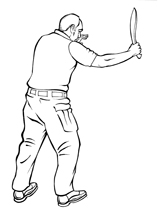


The Reinhardt Snap starts as a punch.
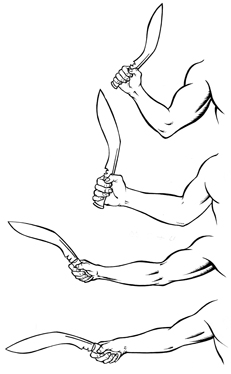
Reinhardt Snap.
This is an excellent cut to maim your opponents’ hands, forearms, neck, and face. If your opponent’s hand sticks out far enough from his body, then make this fast, snapping cut at his hand. If the throat is exposed, make the same cut to the throat on either the left or the right side. This is a very quick snapping cut in and out. If you can get enough small cuts on hands, forearms, throat, or legs—with minimal danger to yourself—you will come out a winner at the end.
Then practice the sweep. That’s using your non-knife hand and forearm to push your opponent’s knife out of the way. This is very tricky stuff but if well-timed can be a real winner. Quickly step in and use your non-knife-holding hand to drive your opponent’s knife hand away from you. Quickly close with your opponent and cut him across the carotid artery in his neck, then step back out of the way equally fast. This move also can be done by sweeping your opponent’s knife hand to one side and striking the inside of his arm. Then as you close, stab your opponent quickly in the groin. Once again you must be in and out quickly. There is a great deal of danger to both these moves, but with practice they are hard to beat.
If your opponent closes with you, you are not easily able to make a cut. This is where sawing on your opponent comes in handy. The best places to use your knife in this situation are the tendons behind his leg, on his ankle, and under his armpits. This is also an excellent method if somebody grabs you and takes you to the ground, where you have no room to stab or try another type of cut. The method is simple: put your knife on a joint of his body and with all the pressure you can muster, saw back and forth. Hopefully, you will get an artery or a tendon which immobilizes him. If nothing else, he will want to turn loose of you and that is what you want him to do. This is why we need to have continuous motion. Try not to let your opponent close with you—keep moving to the left and right, backward and forward.
The slashing cut has great merit. The areas we want to attack are the top of the forearm, on the upper inside of the biceps, the stomach, and inside the thigh. This is a little slower than the Reinhardt Snap but covers a great deal of damage area. A slash on the collarbone all the way across the body to a man’s bellybutton, about an inch-and-a-half deep, will just about let you go home smiling. Once again: in and out quickly. This can be left to right, or right to left, across either side of the neck. You can close in, make this long slash, and pull out. But there’s a lot of exposure to you on a cut like this. It’s much better to break your opponent down with the Reinhardt Snap than to risk a long slash across your opponent’s body.
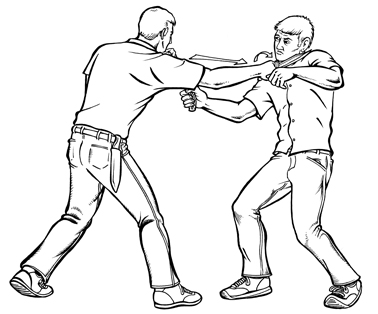
A snap cut to the neck.
While we are on this subject, let’s get rid of this crap about “just taking the cut.” If your opponent has a sharp knife, the first cut you receive probably will be your last. There are times that maneuvers like a sweep or an arm lock may expose you to a cut, but to intentionally throw your arm up to block a cut, and to take that cut across your forearm, is a quick trip the loser’s corner. It’s all about speed and maneuverability, not letting your opponent chop you up.
THRUSTING
The thrust is a very effective but dangerous move with small knives. You must get perilously close to your subject to make it work, and much of your body will be exposed during the maneuver. Recall that with pocket knives there isn’t much blade to work with. You also have to worry about what you might hit when you suddenly strike out at an opponent. The rib cage and sternum present a lot of resistance. As discussed above, other objects like zippers, big iron buttons, and the clutter people carry in their top pockets can deflect or even break the point of your knife. Your target area is limited, so thrust below the sternum, moving in and out extremely fast.
Your throat, forearm, and stomach are all immediately exposed during a straight line thrust. But at the same time your opponent presents you with some choice targets: the front of his throat, the inside of his arms, the inside of his thighs, and his groin. The ability to hit these small areas will depend in large part on the amount of practice you expend and the speed and consistency you develop during these practice sessions.
Most importantly, you must not telegraph the fact you are about to thrust or the direction that thrust will take. Practice in front of a mirror might reveal damaging clues, or “tells,” which could enable your foe to dice you up before your thrust can get underway. A thrust is not unlike the Reinhardt Snap. One needs to explode into a rigid stab, then pop back out of the way. Once again this is easy to practice. Set a water filled plastic container at about chest height and mark a target on it with a one inch square piece of duct tape. When you are poised and ready to make strike, have your sparring partner say “go!” then thrust and try to hit the small piece of tape. Once again start slowly, and with practice build up speed. The most important thing is to be able to hit the tape consistently. Once you have acquired accuracy, then work on speed.
So, you have worked at it and have both speed and accuracy down pat? Now take the knife and conceal it in your pocket. Then practice drawing your knife and thrusting at the piece of tape. Once again start slowly and cautiously. Make sure all of your body parts are safely out of the way—hands, arms, legs, etc. Make sure your footwork is correct. You need a strong, wide foot stance, so that you are in no danger of slipping or sliding. This practice also helps you measure distance correctly, so you will know how close you need to be to an opponent before thrusting.
9
FIGHTING WITH THE BIG KNIVES
Hank picked three big knives to represent this whole category: the Bowie knife, the kukri, and the dagger. He felt that this trio of cutting weapons generally covered the whole field.
KUKRI
First we have the kukri.

Nepalese kukri, 18.5 inches overall length.
HRC42
The first time I saw this type of weapon, it was a picture, not the actual knife. I was sitting in Hank’s den looking through
Stone’s Glossary
of weapons. I noticed this large knife with an unusual shape.



The three basic forms of the kukri:
a) the Sirupate kukri favored by the Limbu tribe,
b) the Bhujpore style favored by the Rais,
c) the standard kukri favored by the other tribes.
Illustration by Peter Fuller.
After our discussion about the kukri, Hank told me he would like to get another for his collection. Little did we know at this time, but the kukri would put him back in touch with Bill Adams, and the two of them would conspire to create Museum Replicas Ltd.
For ages the kukri has been both tool and weapon to the Gurkha natives of little Nepal in the Himalaya Mountains between India and China. Many Gurkhas have fought for the British Army since the nineteenth century and covered themselves with distinction for their fidelity and deadly skill with the kukri.

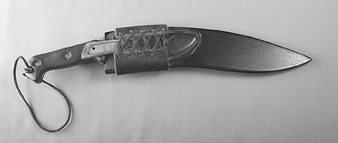
Reinhardt combat kukri, in and out of its sheath. 17½ inches overall length.
HRC649
In World War II the Gurkhas slashed a bloody trail through the German Army in Italy’s Arno Valley. In one encounter, while cleaning Germans out of farm houses, Officer Jemanadar Bakhandho Rai killed six Germans and Jemadar Harkajit Limbu accounted for another five, all with kukris. Two German tanks which were advancing were leaped upon by the Gurkhas and their crews sliced to pieces.

M43 World War II Kukri, 17 inches overall lenth.
From the collection of Greg Phillips.
So don’t let anyone convince you the kukri is not a legitimate weapon of modern war. As a weapon the kukri has much to offer us. It provides length, speed, and power.
Kukris come in a bewildering array of shapes. Basically we will separate the types by saying there are vintage kukris and modern kukris. Atlanta Cutlery still offers a military issue kukri. On this you pay your money and you take your chances; it is a work in progress. If you are handy with hand tools, with a little elbow grease and a little grinding, you could produce a pretty good weapon.
There are a lot of vintage kukris floating around, some from World War II, and some a little older. There are also some current manufacturers who make an excellent product. One example is Cold Steel. They manufacture an excellent standard Limbu-style kukri, similar to a Bhujpore shape.
In the days of the single-shot rifles, kukris were very large, many of them exceeding fourteen inches in length. As repeating firearms came into vogue, kukris shrank, to an average of twelve to thirteen inches. At these lengths a tremendous amount of cutting power is still available. Suddenly our target areas begin to change. It is possible now to chop into the upper part of an opponent’s forearm and not just cut through to the bone, as we did with a pocket knife, but to shear all the way through the arm.
Never doubt that the kukri is a modern weapon. Recently a band of about forty robbers traveling on a passenger train in West Bengal, India, started stealing jewelry, cell phones, and cash. A Nepalese soldier had about all of this he was going to put up with, especially when a group of robbers began to molest a young girl sitting next to him. He began attacking them with his kukri, and he killed three and injured eight others. Even in the modern world, a highly motivated mind and a sharp knife can still prevail.
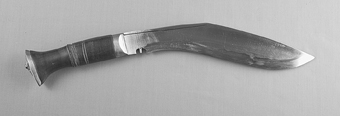
Current issue kukri with wooden handle, 15 inches overall length.
From the collection of Greg Phillips.
You are not just cutting fingers now with the Reinhardt Snap, but you’re cutting fingers off. Your target now expands past the soft portions of the throat and includes the side of the head all the way down to the point where the neck joins the shoulder. We can now slice through the clavicle and into the body. The back of the knee is just an annoyance with a pocket knife, but with the kukri you can now put an opponent on the ground with one cut.
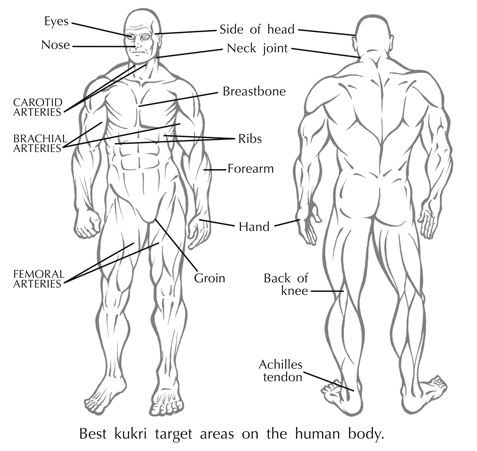
All the moves we talked about with the pocket knife are considerably more deadly once we go up in size. There are those who say the kukri is no good in a thrust, but with the proper hand hold on the grip, we can now drive straight forward with a hard thrust and shear through the breast bone or ribs. It is definitely not the best design for a thrust, but it can work.
